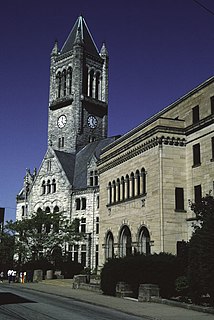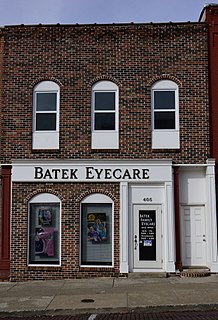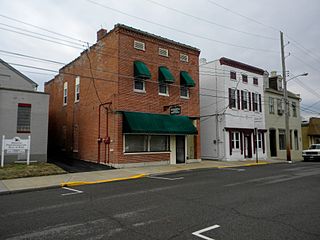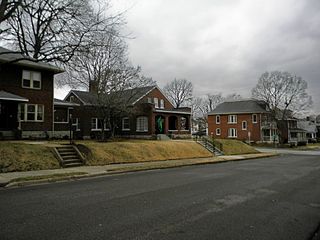
The Washington Avenue Historic District is located in Downtown West, St. Louis, Missouri along Washington Avenue, and bounded by Delmar Boulevard to the north, Locust Street to the south, 8th Street on the east, and 18th Street on the west. The buildings date from the late 19th century to the early 1920s. They exhibit a variety of popular architectural styles of those years, but most are revival styles or in the commercial style that would later come to be known as the Chicago School of architecture. Most are large multi-story buildings of brick and stone construction, built as warehouses for the St. Louis garment district. Many have terra cotta accents on their facades. After World War II, the decline in domestic garment production and the preference for single-story industrial space led to many of the buildings being vacant or underused due to functional obsolescence.

The Washington Park Historic District is a national historic district located in Indianapolis, Indiana. It was listed on the National Register of Historic Places on June 24, 2008. It comprises nearly 60 acres (240,000 m2) and is located 4 miles (6.4 km) north of downtown Indianapolis, in the south-central part of the Meridian-Kessler neighborhood. The district includes all properties south of 43rd Street and north of 40th Street, and west of Central Avenue and east of the alley running north and south between Pennsylvania and Meridian Streets; Washington Boulevard runs north-south through the center of the district. It includes 110 contributing buildings, ranging mostly from mansions to small bungalows, and three non-contributing buildings.

East Campus is a neighborhood of Columbia, Missouri directly east of the University of Missouri and downtown Columbia. The area contains historic residential property as well many Greek student organizations houses. The district contains parts of Stephens College, the Boone Hospital Center's campus and the historic Lee Street Deli. It developed between about 1895 and 1945, and includes representative examples of Tudor Revival, Colonial Revival, and Bungalow / American Craftsman style architecture.

The North Ninth Street Historic District is a national historic district located at Downtown Columbia, Missouri, USA. It encompasses seven contributing buildings in an area that has historically been a center of commerce, recreation and culture. They were built between about 1885 and 1954, and are the L.J. Slate Billiard Hall, Allen Arnold Building, A. Victor Building, Lafayette Hume Building, Varsity Theatre (1927), Crosswhite Bakery, and Hume Building. The popular music venue The Blue Note is located within the district.

There are nine historic districts in Meridian, Mississippi. Each of these districts is listed on the National Register of Historic Places. One district, Meridian Downtown Historic District, is a combination of two older districts, Meridian Urban Center Historic District and Union Station Historic District. Many architectural styles are present in the districts, most from the late 19th century and early 20th century, including Queen Anne, Colonial Revival, Italianate, Art Deco, Late Victorian, and Bungalow.

There are 68 properties listed on the National Register of Historic Places in Albany, New York, United States. Six are additionally designated as National Historic Landmarks (NHLs), the most of any city in the state after New York City. Another 14 are historic districts, for which 20 of the listings are also contributing properties. Two properties, both buildings, that had been listed in the past but have since been demolished have been delisted; one building that is also no longer extant remains listed.

Downtown Johnstown Historic District is a national historic district located at Johnstown in Cambria County, Pennsylvania. The district includes 109 contributing buildings, 4 contributing sites, and 1 contributing structure in the central business district and surrounding residential areas of Johnstown. The district includes some buildings dated before the Johnstown Flood, but the majority date from 1890 to 1930. Notable buildings include the Alma Hall (1884), Bantley Building (1888), Stenger Dry Goods Store (1883), Widmann Building (1892), Cambria Iron Office Building, St. Vincent DePaul Building, Swank Building (1907), Glosser Brothers Department Store (1905), Johnstown City Hall (1900), former U.S. Post Office (1912), State Theater (1926), U.S. Post Office (1938), Franklin Street United Methodist Church (1869), St. John Gualbert Cathedral (1896), First United Methodist Church (1911), Elks Building (1903), and Moose Building (1917). Located in the district and listed separately are the Cambria Public Library Building, G.A.R. Hall, and Nathan's Department Store.

Uniontown Downtown Historic District is a national historic district located at Uniontown, Fayette County, Pennsylvania. The district includes 113 contributing buildings and 1 contributing site in the central business district of Uniontown. Most of the contributing buildings were built between 1881 and 1932, and are representative of a number of popular architectural styles including Classical Revival, Moderne, Late Victorian, and Georgian. Twenty-two buildings date between 1811 and 1860. Notable buildings include the Fayette Bank Building (1902), Thompson-Ruby Building (1900), Highland House (1890), State Music Hall (1922), Exchange Hotel (1891), Galltin Apartments (1929), Gallatin Bank Building (1924), Federal Building (1930), Fayette County Courthouse (1892), County Building (1927), Central School (1916), and St. Peter's Episcopal Church (1884).

This is a list of the National Register of Historic Places listings in downtown Kansas City, Missouri.

Monroe Downtown Historic District is a national historic district located at Monroe, Union County, North Carolina. It encompasses 25 contributing buildings and 1 contributing object in the central business district of Monroe. The district developed during the late 19th and early 20th centuries and includes notable examples of Late Victorian and Classical Revival architecture styles. Located in the district is the separately listed Union County Courthouse. Other notable buildings include the Hotel Joffre Building (1917-1919), Bank of Union Building (1905-1906), Belk/Bundy Building (1911), Monroe Bank & Trust Company Building (1919-1920), Monroe Hardware Company Building (1928), and Secrest Building (1928).

Downtown Fulton Historic District is a national historic district located at Fulton, Callaway County, Missouri. It encompasses 57 contributing buildings and 1 contributing structure in the central business district of Fulton. It developed between about 1877 and 1954, and includes representative examples of Italianate, Second Empire, Colonial Revival, and Classical Revival style architecture. Some of the buildings were designed by noted local architect Morris Frederick Bell. Notable buildings include the Southern Bank of Fulton, Masonic Lodge (1872), Home Savings Bank, Montgomery-Bell Dry Goods, Humphreys-Atkinson-Reid Furniture Company, Fulton Cinema (1926), Kingdom Oil Company (1937), First Christian Church (1911), Adams Building (1890), and U.S. Post Office (1915).

Pleasant Hill Downtown Historic District is a national historic district located at Pleasant Hill, Cass County, Missouri. The district includes 53 contributing buildings, 1 contributing site, and 1 contributing structure in the central business district of Pleasant Hill. It developed between about 1865 and 1959, and includes representative examples of Italianate, Queen Colonial Revival, and Classical Revival style architecture. Notable buildings include the Missouri Pacific Depot (1903), Sinclair Fuel and Service Station, Benson Brothers Lumber Company (1925), J. R. Prewitt & Sons Manufacturing, Inc., Knorpp's Opera House, Wherritt Building (1924), Booth Public Library (1948), Municipal Power Plant (1939), Pleasant Hill Post Office (1938), Tucker Inn (1911), Pleasant Hill City Hall (1959), and Memorial Building (1948).

Tibbe Historic District, also known as the Lustigestrumpf Historic District, is a national historic district located at Washington, Franklin County, Missouri. The district encompasses 23 contributing buildings in a predominantly residential section of Washington. The district developed between about 1857 and 1941, and includes representative examples of Queen Anne, Colonial Revival, and Bungalow / American Craftsman style residential architecture.

Locust Street Historic District is a national historic district located at Washington, Franklin County, Missouri. The district encompasses 123 contributing buildings in a predominantly residential section of Washington. The district developed between about 1839 and 1949, and includes representative examples of Italianate, Queen Anne, Colonial Revival, and Bungalow / American Craftsman style residential architecture. Located in the district is the separately listed Franz Schwarzer House. Other notable buildings include the Lucinda Owens House (1839), Frederich Griese House, Sophia Greiwe House, Presbyterian Church (1916), Hy. Oberhaus House, Gustav Richert Apartment Building, Southern Presbyterian Church/Attucks School (1868), Washington High School (1887), andAME Church

Mid-Town Historic District is a national historic district located in Springfield, Missouri, United States. The district encompasses 455 contributing buildings, 8 contributing structures, and 7 contributing objects in a predominantly residential section of Springfield. The district developed between about 1871 and 1952, and includes representative examples of Late Victorian, Colonial Revival, and Bungalow / American Craftsman style architecture. Located in the district are the separately listed Bentley House and Stone Chapel. Other notable buildings include buildings on the Drury College campus, Central Christian Church (1926), St. Johns Episcopal Church (1886), Mary S. Boyd School (1911), and Trinity Lutheran Church.

Joplin Downtown Historic District is a national historic district located at Joplin, Jasper County, Missouri. The district encompasses 48 contributing buildings in the central business district of Joplin. It developed between about 1883 and 1958 and includes representative examples of Mission Revival, Art Deco, and Modern Movement style architecture. The district includes the previously listed Fifth and Main Historic District, Newman Brothers Building, Fox Theater, and St. Louis and San Francisco Railroad Building. Other notable buildings include the Liberty Building (1923), Cunningham Bank / Quinby Building, Model Clothing Store Building, Lichliter-Kassab Building, Zelleken Block, Muenning Building, and Frank Hollcroft Livery Building.

Downtown Webb City Historic District is a national historic district located at Webb City, Jasper County, Missouri. The district encompasses 43 contributing buildings in the central business district of Webb City. It developed between about 1883 and 1965 and includes representative examples of Italianate, Renaissance Revival, Romanesque Revival, Art Deco, and Streamline Moderne style architecture. Located in the district is the previously listed Middle West Hotel. Other notable buildings include the National Bank, S. Morris Department Store, Morris Opera House and Royal Furniture Co., The Unity Building and Merchant and Miners Bank, Aylor Building / Odd Fellow Hall, Mystic Theater, Newland Hotel, Dickenson Theater, Civic Theater, U.S. Post Office, and the Old U.S. Post Office / Wagner Building.

Downtown Troy Historic District is a national historic district located at Troy, Lincoln County, Missouri. The district encompasses 39 contributing buildings, 1 contributing site, and 2 contributing structures in the central business district and surrounding residential area of Troy. It developed between about 1832 and 1966, and includes representative examples of Late Victorian style architecture. Notable buildings include the Sherman Cottle House (1832), St. Stephens Methodist Church (1900-1901), Lincoln County Jail/Jailer's House (1876), Sacred Heart Catholic Church (1954), Lincoln County Courthouse (1869-1870), Troy Post Office, Farmers & Merchants Bank / Masonic Lodge (1906), Universalist Church / Masonic Hall (1837/1851), Lincoln County Motor Co. (1929), and United Baptist Church (1937).

The Alma Downtown Historic District in Alma, Kansas, a 5.6 acres (2.3 ha) historic district in Alma, Kansas, was listed on the National Register of Historic Places in 2009. It includes 21 contributing buildings.

The Downtown Hartford Historic District in Hartford, Kentucky is a 4 acres (1.6 ha) historic district which was listed on the National Register of Historic Places in 1988.






















